Location of Ancient Crete
The island of Greek Crete Crete is located right in the center of the eastern Mediterranean at the crossroads of Africa, Asia, and Europe. It measures about 200 Km from east to west, and between 12 to 58 Km from north to south at its narrowest and widest distances thereby occupying the place as one of the largest islands in the Mediterranean sea and it became the center of one of the earliest advanced civilization of Europe which lasted from 2700-1420 BC.
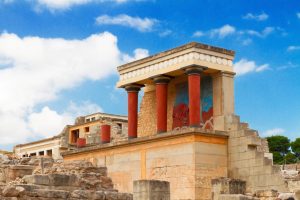
Ancient Greek Crete
The inhabitants of ancient Greek Crete well known as the Minoans produced somewhat of a decentralized culture because of the abundance of the land’s natural resources coupled with intense commercial activity. In ancient time, timber was one of the natural resources that were commercially exploited and exported to nearby Egypt, Syria, Cyprus, the Aegean Islands as well as the Greek mainland.
Apart from timber, Greek Crete exported commodities like olive oil, currants, wool, cloth, herbs, and purple dye while its imports consisted of precious stones, copper, ivory, silver, gold, and other raw material. Apart from the tin which was used in the production of bronze alloys. Interestingly, the nearest known tin mines appear as far as Spain, Britain, central Europe, and Iran.
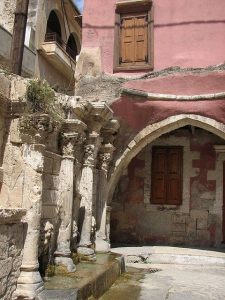
The Minoans developed significant naval power and for many centuries lived in contact with all the major civilizations of that time without being significantly threatened by external forces.
Their commercial contact with ancient Egypt and Mesopotamia undoubtedly influenced their own culture, and the Minoan civilization, in turn, appeared as the forerunner of the Greek civilization. The Minoans are credited as the first European civilization.
Archaeological
Archaeological excavations have testified to the island’s habitation since the 7th Millennium BC After the 5th millennium BC, the first evidence of hand-made ceramic pottery which marked the beginning of the civilization Evans, the famed archaeologist who excavated Knossos, named “Minoan” after the legendary king Minos can be found.

Evans divided the Minoan civilization into three eras based on the stylistic changes in the pottery. This comparative chronology included an Early (3000-2100 BC), a Middle (2100-1500 BC), and a Late Minoan period (1500-1100 BC). Owing to some practical difficulties in studying the culture, Professor N. Platon developed a chronology based on the palaces’ destruction and reconstruction.
He divided Minoan Crete into Prepalatial (2600-1900 BC), Protopalatial (1900-1700 BC), Neopalatial (1700-1400 BC), and Postpalatial (1400-1150 BC). The details about the very early Minoans before 2600 BC, however, cannot be traced.
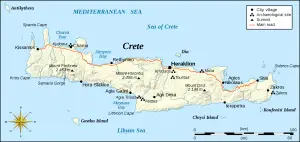
The Phases of Minoan Crete
Prepalatial Minoan Greek Crete(2600-1900 BC):
During the Neolithic life in ancient Crete, major settlements consisted of Myrtos and Mochlos. During this period the Minoans had contact with Egypt, Asia Minor, and Syria with whom they traded for copper, tin, ivory, and gold.
The archaeological evidence reveals a decentralized culture with no powerful landlords and the absence of any centralized authority. The palaces of this period are focused on communities, and circular tholos tombs were the major architectural structures of the time.
The manner in which the dead were buried in these tombs indicated a society without a hierarchical structure. The tholos tombs were used for centuries by entire villages, or clans and older corpses and offerings were placed aside to make room for a new burial. Older bones were removed from the tomb and placed in bone chambers outside the Tholos structure. Most of the tholos tombs were circular while in Palekastro and Mochlos they were of a rectangular in shape with a flat roof.

Protopalatial Minoan Crete (1900-1700 BC)
The proto palatial era began witnessed a social upheaval, external dangers, and migrations from mainland Greece and Asia Minor. Durcentress time the Minoans established colonies at Thera, Rodos, Melos, and Kithira. Around 2000 BC a new political system was established whose authority concentrated around a central figure which was a king.
The first large palaces were founded and acted as centers for their respective communities, while at the same time they also developed a bureaucratic administration which infused the Minoan society.

Differences between the classes falsified a social hierarchy and divided the people into nobles, peasants, and slaves. After its turbulent beginning, this was a comparatively a peaceful and prosperous period for the Minoans who continued to trade with Egypt and the Middle East, while they constructed a paved road network to connect the major cultural centers.
This period also marked the development of some settlements outside the palaces, as well as the end of the extensive use of tholos tombs.The palaces of the period were destroyed in 1700 BC by some unknown forces. However, in spite of the abrupt destruction of the palaces, the Minoan civilization continued to flourish.
Neopalatial Minoan Greece Crete(1700-1400 BC)
The destroyed palaces were speedily rebuilt to form even more magnificent structures. This was the time when Knossos, Phaistos, Malia, and Zakros were built, along with many smaller palaces which stretched along the Cretan landscape.
Small towns developed near the palaces. For the first time, smaller residencies like the present day villas appeared in the rural landscape and consisted of storage facilities, worship, and workshops.
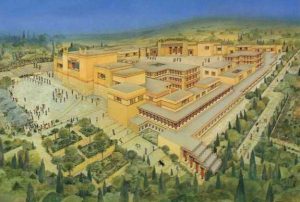
These houses were believed to have belonged to the affluent landlords. During this period, administrative and economic unity throughout the island, and Minoan Crete had reached its all-time high. Women played a powerful role in society. The Minoan culture’s fusion with the Helladic which was mainland Greek traditions of the time eventually morphed into the Mycenaean civilization, which in turn challenged the Minoan supremacy in the Aegean.
Life on the island became more militaristic as evident by a large number of weapons. The end of this flourishing culture came with the destruction of most of the palaces and villas of the countryside in the middle of the 15 century, and with the destruction of Knossos in 1375.
During this late period, evidence in tablets inscribed in Linear B language point out that the Mycenaeans controlled the entire island, while many Minoan sites were abandoned for a long time, the causes of which remain unknown till today.
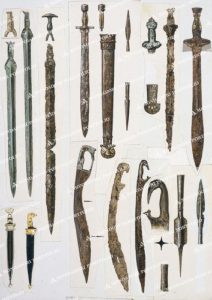
Postpalatial Period (1400-1150 BC)
The destruction of Knossos, brought a shift in power the power from the Aegean to Mycenae. In spite of both Knossos and Phaistos remaining active centers of influence, they no longer acted as the central authority of the island. During the post-palatial period, the western part of Crete flourished. Several important settlements developed around Kasteli and Chania, while Minoan religion began exhibiting Greek influences as well.
An examination of the changes which took place in the Minoan society during this period revealed that most likely Mycenae controlled Crete. During this period, Helladic god names such as Zeus began appearing in tablets. Additionally, new shapes came to be introduced in pottery, and vaulted tholos tombs appeared for the very first time.

Post Minoan Crete
By 1420, the Minoan civilization went into decline and was replaced by the Mycenaean civilization which linked them to the ancient Greek world.
Sub-Minoan Crete (1150-1100 BC) – Around 1150 BC, the Dorians destroyed the Mycenaean civilization and by 1100 BC arrive at Crete. This period marked the assimilation of all remaining Minoan elements of Crete into the new Hellenic culture. This new culture eventually changed into the Classical Greek civilization which had its hub in Athens.
We get very little information about ancient Crete in the archaic and classical as very little interest is shown by the Greek historiography about Crete.
Greek Crete which was the center of Europe’s first advanced civilization gave birth to the Minoan civilization. This civilization wrote in the undecipherable script known as Linear A which is available to us in the form of tablets with information encrypted on them as a result of which we can come to know not only about the history but also about the way of life of the Minoan civilization.